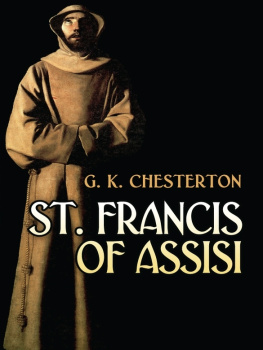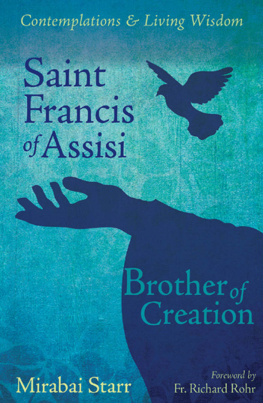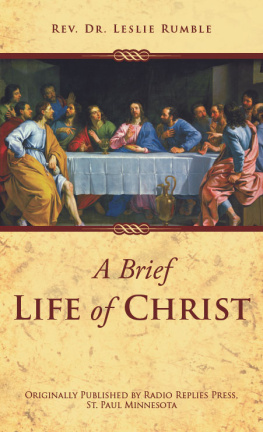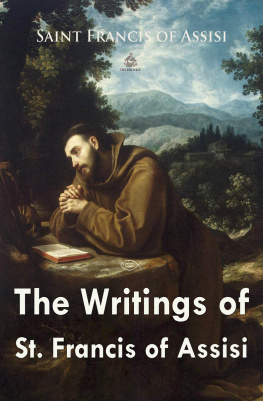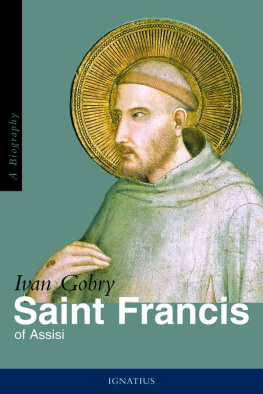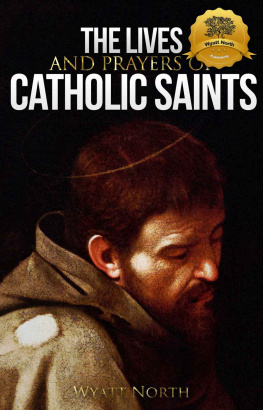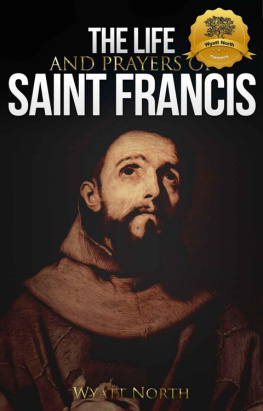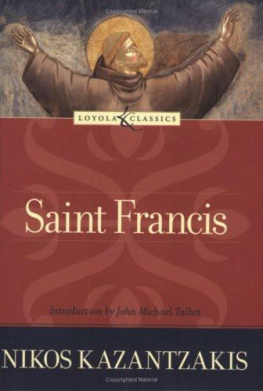LOOKING
TO
ST. FRANCIS
The Man from Assisi
and His Message of Hope for Today

John Bohrer and
Joseph Stoutzenberger
Copyright 2014 by John Bohrer and Joseph Stoutzenberger
All rights reserved
Published by The Word Among Us Press
7115 Guilford Road
Frederick, Maryland 21704
www.wau.org
18 17 16 15 14 1 2 3 4 5
ISBN: 978-1-59325-254-0
eISBN: 978-1-59325-458-2
Unless otherwise noted, Scripture passages contained herein are from
the New Revised Standard Version Bible: Catholic Edition,
copyright 1989, 1993, Division of Christian Education of the National
Council of the Churches of Christ in the United States of America.
Used with permission. All rights reserved.
Scripture passages marked NAB are taken from the New American Bible,
revised edition, copyright 2010, 1991, 1986, 1970, Confraternity of
Christian Doctrine, Washington, DC, and are used by permission of the
copyright owner. All rights reserved. No part of the New American Bible
may be reproduced in any form without permission in writing from
the copyright owner.
Cover design by Koechel Peterson & Associates
Photo credit: Thinkstock, Sunset over the town of Assisi, Umbria, Italy
No part of this publication may be reproduced, stored in a retrieval
system, or transmitted in any form or by any meanselectronic,
mechanical, photocopy, recording, or any other, except for brief
quotations in printed reviewswithout the prior permission of the author
and publisher.
Made and printed in the United States of America
Library of Congress Control Number: 2014935520
For those who have shown me Franciscan hospitality:
Rosemarie Kolmer, OSF, Fr. Terry M. Odien, and
Bishop Joseph A. Galante
JDB
For my grandchildren: Erin, Brendan, Flynn, Cormac,
and Thomas
JMS
CONTENTS
INTRODUCTION
FRANCIS, MIRROR OF GOSPEL LIGHT
The people who walked in darkness
have seen a great light;
those who lived in a land of deep darkness
on them light has shined.
Isaiah 9:2
One Christmas Eve a medieval Italian man, who already had a reputation for quirky expressions of holiness, was overwhelmed at the thought that the almighty, pure, and transcendent God would become human. And not simply human but a fragile, helpless child. Born not in a proper dwelling but in a stable. Resting not in a bed but in a crib of straw. The announcement of the birth of Jesus went out not to kings and queens but to shepherds enduring the cold night with their sheep.
So Francis of Assisi set up an altar outside of town. He gathered together some straw, placed it in a bin in front of the altar, and brought in an ox and a donkey. In this humble setting, Christmas Eve Mass was celebrated, with Francis delivering a sermon about the little child of Bethlehem. The townspeople with Francis that night understood the message that he was trying to convey: Jesus, the Christ child, warmed against the cold by his mothers arms and the breath of animals, was EmmanuelGod with us.
Francis knew instinctively that words were not sufficient to communicate the glorious message of the Incarnation. A simple, silent reenactment of the wondrous Christmas event brought the message to life better than words ever could. Thats because words tend to come from the head, while God becoming human is a matter of the heart. The image of baby Jesus in the manger, surrounded by simple farm animals, evokes the beauty of Christmas as well as its messiness. After all, real animals are dirty and smelly, and they do dirty and smelly things. What was the Christ child doing in such unpleasant circumstances? The circumstances surrounding his birth set the stage for where hed be spending his time later in his lifewith lepers and sinners!
Ever since Francis time, the Christmas crche has been reproduced in nearly every culture and society on earth, and Francis has been revered as perhaps our greatest saint. Like the baby Jesus born in a stable, Francisdressed in a patched and dirty robereminds us that holiness can be found in the commonplace, where we live most of our lives. He remains for us today, Catholics and non-Catholics alike, an image of light in darkness. In his life story, we find the heart of the Christian message.
Communicating the Message of Jesus
Even before he died, his contemporaries honored Francis, the poor man of Assisi, as a saint. He has lost none of his appeal for people today. Thats because the message of Francis for us is, quite simply, the message of Jesus. He didnt couch it in sentimental or pious words and practices. He went to the heart of the matter and stayed there, finding pain and suffering but also great joy. His intensity and passion for the gospel stand out as uniquely characteristic of his spirituality. As a result, he lived the gospel as no one else had ever done.
Francis of Assisi made his point more dramatically and effectively than simply through words, even though he moved people to tears or to the height of joy when he did preach. He typically spoke to the common people of his day through actions, gestures, and images, as well as words. For instance, Francis once gave a sermon on poverty while he and another brother stood in the church wearing only their underwear. His words moved the crowd to tears, but without the visual representation of being nearly naked before the Lord and the assembly, his words surely would have been much less powerful.
Francis knew what we moderns have empirically proven: the medium is the message. And for Francis, the greatest medium communicating Gods message about poverty, suffering, hope, and joy was Christ himself. Francis life was the embodiment of a saying attributed to him that clearly reflects his spirit: Preach the gospel always. When necessary, use words. In the rule he set out for his community, he admonished his brothers to preach through their deeds.
We now have Pope Francis. When he was elected in 2012, Cardinal Jorge Bergoglio of Argentina broke with precedent and chose the name Francis. The choice of that name signaled a message to the world that this pope wanted Francis of Assisi to be a model for the Church today. And like his namesake, Pope Francis continually speaks his message through his actions. The day after his election, he returned to his hotel to pay his bill in person and placed a call to Argentina to cancel his newspaper subscription. He decided to live in an unadorned room rather than in the papal palace. On his first Holy Thursday as pope, he washed the feet of inmatesyoung men and womenat a local prison. Pope Francis is preaching the gospel through his actions, his gestures, the way he speaks, the smile on his face, and even the style of clothing he wears.
This same dynamic draws us to Francis of Assisi. If we only had his words, he would not be the inspiration he is for so many of us. Instead, we are moved by his gestures, such as exchanging his fine clothes for a beggars robe, delighting in music and nature, and smiling with joy at the thought of Gods love despite his physical suffering.
Addressing the Challenges of Our Times
Francis of Assisi shed light on what it means to be Christian for the entire medieval world, which was then facing a host of new challenges. Through bold, evocative actions, Francis addressed the darkness of constant warfare, class conflicts, rampant poverty, fear and ignorance about diseases such as leprosy, and church and state rulers who coveted power and wealth more than caring for the needs of those entrusted to them. Catholics today also face many challenges of our own in our personal lives, in our world, and in our Church. Stories about Francis are like snapshots from old that can help us as we try to navigate through our own spiritual crises, challenges, and journey.
Next page





